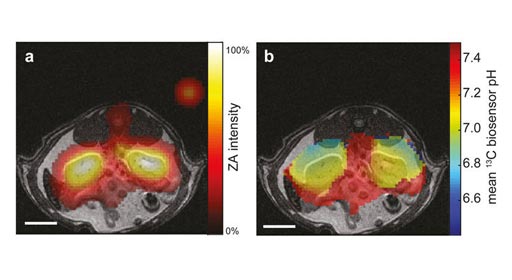MRI Helps Detect pH Changes in Tumor Tissue
By MedImaging International staff writers
Posted on 31 May 2017
A new study demonstrates how hyperpolarized 13C-labelled zymonic acid (ZA) can be used as a magnetic resonance imaging (MRI) pH imaging sensor.Posted on 31 May 2017
Researchers at Munich Technical University developed the pH imaging sensor using ZA marked with carbon-13 in order to be visible in MRI images. In order to make pH values visible using ZA, the molecule is first hyperpolarized using microwaves at very low temperatures; a hot liquid is then used to quickly return the ZA to room temperature. The biosensor is then injected into the body, and the scan is performed immediately, as the hyperpolarization effect wears off in 60 seconds.

Image: Hyperpolarized ZA measurements compared to pH-values in a rat kidney (Photo courtesy of Franz Schilling / TUM).
When inside the MRI, the magnetic field waves excite the nuclear spins of the ZA to oscillation. The reactions of the nuclei are then recorded, and the data is used to calculate frequency spectra, which in turn provide information about the chemical properties of the molecular surroundings of the nuclei. The pH value at any examined location in the tissue can be represented based on molecular changes in the ZA. The researchers have succeeded in showing that their method is sensitive enough to represent medically relevant pH value changes in the organism.
The researchers conducted studies in rat kidneys and subcutaneously inoculated tumors derived from a mammary adenocarcinoma cell line, generating in-vivo pH maps, and also successfully characterized ZA as a non-toxic compound predominantly present in the extracellular space. The researchers also suggest that in contrast to current optical methods, which are limited to superficial penetration into the body due to the low transparency of tissue, there are no limitations to the depth of penetration for MRI. The study was published on May 11, 2017, in Nature Communications.
“Areas surrounding tumors and inflammations are usually slightly more acidic than areas surrounding healthy tissue, a phenomenon possibly linked to the aggressiveness of tumors,” said senior author TUM physicist Franz Schilling, PhD. “pH values are also interesting when it comes to evaluating the efficacy of tumor treatments. Even before a successfully treated tumor starts to shrink, its metabolism and thus the pH value of the surrounding area could change. An appropriate pH imaging method would indicate at a much earlier stage whether or not the right approach has been selected.”
The hyperpolarized spin state exists at very low spin temperature that are not in a thermal equilibrium with the temperature of the tissue, which leads to high magnetization of the spin ensemble, resulting in very high nuclear magnetic resonance signal intensity. The hyperpolarized spin state eventually returns to the thermal equilibrium temperature by depolarization.














